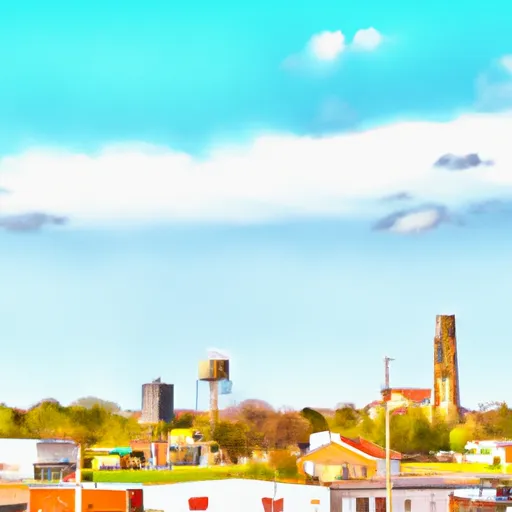-
 Snoflo Premium
Snoflo Premium
Get unlimited access to all our content
With no Ad interruptions! - Start Your Free Trial Login with existing account
Posen
Eden Index
Climate
8.2
•
Recreation
4.2
•
Community
2.0
•
Safeguard
5.2/10

Posen, Illinois, is a small village located in Cook County. The climate in Posen is characterized by cold winters and warm summers, with average temperatures ranging from around 20°F (-7°C) in January to approximately 80°F (27°C) in July. The area receives moderate precipitation throughout the year, with rainfall evenly distributed across the seasons.
Hydrologically, Posen is situated in the Des Plaines River Watershed, which is part of the larger Illinois River Basin. The village does not have any major rivers or lakes within its boundaries, but it is surrounded by waterways like the Little Calumet River and the Calumet Sag Channel.
While Posen itself does not offer specific outdoor recreation opportunities, it is conveniently located near various natural attractions. Nearby Calumet Woods, Midlothian Meadows, and the Cook County Forest Preserves provide opportunities for hiking, biking, bird-watching, and picnicking. Additionally, the nearby Lake Katherine Nature Center and Botanic Gardens offer beautiful landscapes for nature enthusiasts.
In summary, Posen, Illinois, experiences a typical Midwestern climate with distinct seasons. Although it lacks direct access to major water bodies, it benefits from its proximity to rivers and recreational areas, providing residents and visitors with opportunities for outdoor activities and enjoying nature.
What is the Eden Index?
The Snoflo Eden Index serves as a comprehensive rating system for regions, evaluating their desirability through a holistic assessment of climate health, outdoor recreation opportunities, and natural disaster risk, acknowledging the profound impact of these factors on livability and well-being.
Climate Health Indicator (CHI): 8.2
Posen receives approximately
980mm of rain per year,
with humidity levels near 80%
and air temperatures averaging around
11°C.
Posen has a plant hardyness factor of
6, meaning
plants and agriculture in this region thrive during a short period during spring and early summer. Most
plants will die off during the colder winter months.
By considering the ideal temperature range, reliable water supplies, clean air, and stable seasonal rain or snowpacks, the Climate Health Indicator (CHI) underscores the significance of a healthy climate as the foundation for quality living.
A healthy climate is paramount for ensuring a high quality of life and livability in a region, fostering both physical well-being and environmental harmony. This can be characterized by ideal temperatures, reliable access to water supplies, clean air, and consistent seasonal rain or snowpacks.
Weather Forecast
Streamflow Conditions
Upper Illinois
Area Rivers
Upper Illinois
Snowpack Depths
Upper Illinois
Reservoir Storage Capacity
Upper Illinois
Groundwater Levels
Recreational Opportunity Index (ROI): 4.2
The Recreational Opportunity Index (ROI) recognizes the value of outdoor recreational options, such as parks, hiking trails, camping sites, and fishing spots, while acknowledging that climate plays a pivotal role in ensuring the comfort and consistency of these experiences.
Access to outdoor recreational opportunities, encompassing activities such as parks, hiking, camping, and fishing, is crucial for overall well-being, and the climate plays a pivotal role in enabling and enhancing these experiences, ensuring that individuals can engage in nature-based activities comfortably and consistently.
Camping Areas
| Campground | Campsites | Reservations | Toilets | Showers | Elevation |
|---|---|---|---|---|---|
| Oblong Park | None | 491 ft | |||
| Bumpus Mills - Lake Barkley | None | 520 ft | |||
| Robinson City Park | None | 541 ft | |||
| Crawford County Fairgrounds | None | 508 ft | |||
| Gatlin Point - LBL | 19 | 453 ft | |||
| Kimmell City Park | 10 | 415 ft | |||
| Red Hills Lake State Park | 130 | 519 ft | |||
| Ouabache Trails County Park | 45 | 446 ft | |||
| Lincoln Trail | None | 412 ft | |||
| Lincoln Trail State Park | 240 | 655 ft |
Nearby Ski Areas
Catastrophe Safeguard Index (CSI):
The Catastrophe Safeguard Index (CSI) recognizes that natural disaster risk, encompassing floods, fires, hurricanes, and tornadoes, can drastically affect safety and the overall appeal of an area.
The level of natural disaster risk in a region significantly affects safety and the overall livability, with climate change amplifying these risks by potentially increasing the frequency and intensity of events like floods, fires, hurricanes, and tornadoes, thereby posing substantial challenges to community resilience and well-being.
Community Resilience Indicator (CRI): 2.0
The Community Resilience Indicator (CRI) recognizes that education, healthcare, and socioeconomics are crucial to the well-being of a region. The CRI acknowledges the profound impact of these elements on residents' overall quality of life. By evaluating educational resources, healthcare accessibility, and economic inclusivity, the index captures the essential aspects that contribute to a thriving community, fostering resident satisfaction, equity, and social cohesion.

